
Dossiers
 |
Dossier Dossiers |
"Why does he behave like that?" - Film characters' psychology and viewers' causal attributions - Part 2
N.B. A pdf version of this Dossier is available.
5. Emotions and their causes
In the examples we have just provided, emotions play a crucial role, and their meaning is part of what we called "folk psychology". But how do we manage to understand the emotions that a person is feeling, be it a real person or a film character? On which bases, as we closely watch a person, do we attribute a certain emotion to her/him? Surely we need to know several aspects of that person, her/his motivations and expectations; and since emotions tend to be caused by external events (including other persons), we also need to know the context or the situation in which the person shows a certain emotion. This is why we must consider several sets of causal factors that can lead to different affective reactions. In the following table, inspired by Roseman et al. (Roseman I, Antoniou A., Ann A., Jose P. 1996. "Appraisal determinants of emotions: Constructing a more accurate and comprehensive theory", Cognition and Emotion, vol. 10, No. 3, pp. 241-277, quoted in Persson, cit., p 170) we provide a few examples of possible causes that can be responsible for different emotions.
|
(1)
Emotion is positive when consistent with one's personal goals,
negative when it is inconsistent.
Obviously, this is not a complete list of possible emotions. Besides, the same event can cause different emotions: for example, the negative result of an exam can cause sadness, because one was already sure of the negative fact (expected event), or anger, because one feels the victim of an injustice (an event caused by others, e.g. an incompetent teacher), or frustration (because one is aware that she/he could have worked harder = perception of being able to control events), or distress, because one does not think she/he can control events (sense of helplessness). As a matter of fact, emotions are rarely "pure" as they are shown here. We are very often concerned with mixed emotions, also due to the action of several factors or causes.
Understanding the nature of emotions and their causes helps us, on the one hand, to explain, retrospectively, the beliefs, intentions and, ultimately, the behaviours of people or characters; on the other hand, it allows us to create expectations about their future actions and reactions. In both cases we are dealing with inferences, either retrospective or predictive, on the basis of which we start building an interpretation of characters and their motivations, and, as a consequence, of the unfolding of events and of the whole story staged by the film. Thus emotions go a long way towards giving the story a sense of global coherence.
6. Film devices which promote the perception of causal attributions
"To make inferences about characters, we look for connections, for links and clues to their function and significance in the story. In analyzing a character or character's relationships, we relate one act, one speech, one physical detail to another until we understand the character ... We should approach fictional characters with the same concerns with which we approach people. We need to be alert for how we are to take them, for what we are to make of them, and we need to see how they may reflect our own experience. We need to observe their actions, to listen to what they say and how they say it, to notice how they relate to other characters and how other characters respond to them, especially to what they say about each other" (DiYanni R. 1998. Literature. Reading fiction, poetry, drama and the essay, McGraw Hill, Boston, p.60). This is what the audience is expected to do while watching a film, using the clues that the movie is constantly providing: cinema is indeed rich in devices which enable the audience to make inferences, create expectations and formulate hypotheses. Becoming aware of these devices makes the viewer's "job" easier, but above all more absorbing and exciting. Let's consider in particular:
- dialogues, which can make explicit reference to a mental state or an emotion (for example, when a character says, "I am very proud of you", or, "I know very well that you're lying"). Often, however, dialogues work indirecly, by making allusions, suggesting, hinting, etc.;
- characters' physical behaviour: gestures, face expressions, tone of voice, glances ...;
- the temporal dimension during which clues are introduced. As we have just said, characters reveal themselves little by little, as the action proceeds (alternating scenes providing several clues and scenes relatively "empty" in this sense); however, the speed at which we attribute thoughts and emotions to characters varies a lot from film to film, and this is one of the factors that also affect the very "rhythm" of the story. Besides, sometimes these clues are deliberately hidden from the audience, or can be put off to later stages so as to create curiosity, suspense or surprise;
- the distribution of the presence of characters along the story (when and how often do they appear?) and the mise-en-scene itself, i.e. the placing of characters in each scene: several aspects of framing, such as the shot scale (close-up rather than medium or long shot), their presence "on screen" or "off screen", how they are brought into focus, lighting - all of these factors help in establishing the relative importance of each character and her/his relationship with other characters;
- the point of view, alternating a person looking and the person (or object) looked at, as well as the action of looking and the reaction of the person being looked at: this is of the utmost importance in defining characters' psychology. Hitchcock, in his long interview with François Truffaut, has rendered this concept extremely well (by making reference to Rear window, where the protagonist cannot move, with a broken leg in plaster): "You have an immobilised man looking out. That's one part of the film. The second part shows what he sees and the third part how he reacts. This is actually the purest expression of a cinematic idea" (Truffaut F. 1966. Le cinéma selon Hitchcock, Laffont, Paris, p. 161).
In the following examples, we will highlight these film devices which activate the viewers' beliefs and expectations, though which viewers themselves, through a process of inference, create causal attributions for the characters, thus reconstructing the meaning of the film. (The structure of the tables is inspired by Persson, cit.)
7. Examples
Example 1: from Beyond the forest (by King Vidor, USA 1949)
Before the sequence we are going to analyse, we have been introduced to a married couple, Louis and Rosa, living in a small town in Wisconsin. Louis is a scrupolous and generous doctor, while Rosa, unhappy with their modest economic conditions, would do anything to lead a better life. One day,when Louis is suddenly called to assist a woman in labour, Rosa takes advantage of his absence to run to her lover, who owns a luxury villa nearby. The film then shows us alternating scenes of Rosa discussing with her lover and of Louis taking care of the woman. The sequence which follows takes place when Louis, who has just got home tired out from his day's hard work, meets his wife.
N.B. The times shown in minutes and seconds (00:00) refer to the frames appearing on the left.
| FILMIC TEXT | FILM "CLUES" ACTIVATING VIEWERS' BELIEFS AND EXPECTATIONS | MEANINGS: INFERRED ATTRIBUTIONS | |
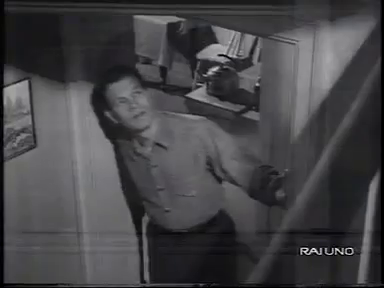 |
00:57 Louis asks Rosa if she got back alright, in a loving and caring tone. | The tone of voice with which we address others denotes one's own attitudes and the relevant emotions | Louis loves his wife and cares for her |
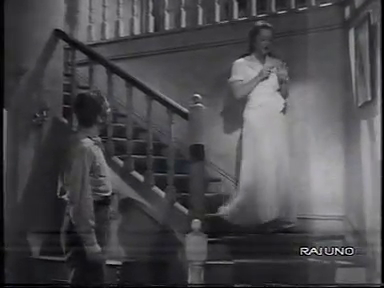 |
01:02 Rosa slowly walks down
the stairs, filing her nails, without looking at Louis. She answers his
question in a sarcastic tone |
Besides the tone of voice, avoiding looking at another person denotes detachment | Rosa is dissatisfied and angry |
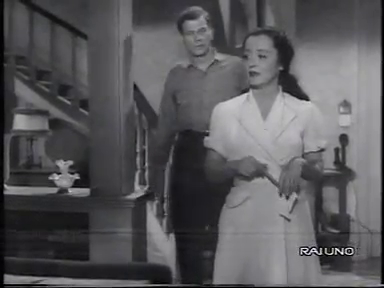 |
01:15 Rosa looks around the room and says huffily: "What a dump!" | Face expressions denote attitudes and emotions, as well as the words used to describe something | Rosa scorns the house |
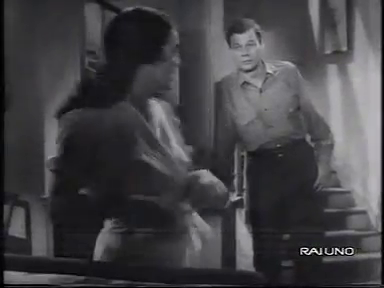 |
01:18 Louis: "Don't start hating it until I've paid it for" | If one's dreams do not come true, one may experience frustration. If the cause of this is attributed to others, one can feel anger and/or contempt. If one thinks she/he can't control the events, one feels helpless. | Rosa would like to have a much better house, but her husband cannot afford it and she has no alternatives. She therefore feels frustrated, angry and helpless |
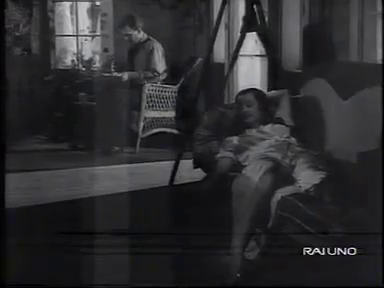 |
01:19 We next see Rose lying on a lawn swing. In the
background, Louis is sitting at a table, eating sandwiches (no dinner
provided!) Louis tries to explain how he loves his work and the feeling of being helpful to others. Rosa retorts that the more people in town hate her, the more she takes pride in being different from them. The conversation proceeds on such lines until Louis stands up and says he's going to bed. Rosa: "That's good news! Where else could you go?" |
The conversation proceeds without eye contact, at a
distance, with Rosa always looking in the opposite direction
to Louis'. Physical distance stresses emotional distance. The dialogue clearly highlights the characters' opposing views, as well as their beliefs and attitudes towards themselves and others, together with the accompanying emotions. If one acts so as to reach one's personal goals, one experiences joy, satisfaction and pleasure (Louis). If, on the other hand, one's own motivations are not fulfilled, and the circumstances are perceived as hostile, one experiences distress and anger. If others are part of such circumstances, one can also feel contempt. If one feels unable to control the events, one feels frustration (Rosa). |
Louis and Rosa have two opposing world views, as well as diverging goals/motivations. The siuation they are in is positive and gratifying for Louis, but totally inconsistent with Rosa's goals. She thus reacts with anger and frustration and shows an aggressive behaviour |
Example 2: from Rashomon (by Akira Kurosawa, Japan 1950)
Japan, 15th century. Several people give different versions of a story in which a woman was raped and her husband killed. The sequence that follows shows the bandit accused of the crime, telling before a court (which we never see or hear) his own version of the facts.
N.B.
1. The times shown in minutes and seconds (00:00) refer to the frames appearing on the left.
2. The symbol "!!! Cultural element" warns that cultural differences may be at work. In such cases, the third column reports a possible "Western interpretation" (remember that folk psychologies can be very different across cultures!).
| FILMIC TEXT | FILM "CLUES" ACTIVATING VIEWERS' BELIEFS AND EXPECTATIONS | MEANINGS: INFERRED ATTRIBUTIONS | |
.png) |
21:33 (a slow musical score starts) | The bandit's harsh, scornful tone of voice, as well as his face expression, denote his attitude and the relevant emotions. | The bandit is a violent man and is still a prey to an emotion which he hardly controls |
.png) |
22:05 (A flashback starts) The bandit is lying under a tree, he seems to be sleeping (the evocative musical score continues) | ||
.png) |
22:22
While the bandit is still in the foreground, we see a man walking,
leading a horse with a woman. The bandit opens his eyes and looks
carefully at the woman, now in a medium shot, then he closes his eyes
(the musical score gets sharper, nearly pressing) |
The bandit looks straight at the woman. | The bandit has seen something which has caught his attention but decides not to act. He doesn't seem interested |
.png) |
22:54 A medium-long shot shows, at the sides of the frame, and separated by a big tree, the bandit on the left and the couple on the right. The two men exchange glances in close-ups, then the bandit seems to go back to sleep | The man has noticed the bandit, stops and looks at him: an unexpected event (meeting a possibly dangerous person in a wood) leads to a negative emotion (surprise). His furrowed brows and careful look also show that the surprise is negative (the man immediately suspects that the man lying under the tree may be a bandit) - this goes along with relevant emotions (worry, maybe fear). Seeing that the bandit does not seem to care, the man is hesitant but walks on. | The man is aware that one can have nasty encounters in a wood, but he does not seem to perceive a real danger at the moment |
.png) |
23:38
The bandit opens his eyes again and suddenly sees the feet of
the woman (subjective point of view), then he quickly looks up
at her face. He keeps looking at the couple walking in front of him, and
then moving away towards the background. Then he lies down again, but
soon grasps his sword ... |
The bandit is now fully awake and his eyes now show surprise and interest. His gestures show that he is now motivated by the thought of the woman... Almost immediately, this motivation leads him to act: he grasps his sword ... | The bandit is excited by the vision of the woman and decides to act |
.png) |
24:29 The flashback is temporarily suspended as the bandit recalls his feelings for the woman | The bandit's facial expression is thoughtful at first, almost absorbed by the memory of the woman ... then suddenly becomes menacing ... | The bandit has no rules, now there is no stopping him from reaching his goal |
.png) |
24:47 As he recollects his thoughts, the bandit bursts out laughing in a sardonic, nearly amused way. Then he starts his story again. |
What is the message conveyed by this laugh?The contempt of any rule? A
sadistic urge to possess the woman? However, intentions and goals are explicitly
stated. !!! Cultural element: what kind of emotions can a laugh convey in the Japanese culure? (The reference to "the road to Yamashina" remains obscure ...) |
(Western interpretation) The bandit is wicked, he is a man of no scruples, maybe even a bit insane ...? |
.png) |
25:36 (The flashback resumes) We see the woman, now sitting by herself, the horse standing beside her. (the musical score becomes lyrical) | The woman
seems to belong to a fairy tale ... !!! Cultural element: can the woman's clothes be interpreted in any particular way in the Japanese culture? |
(Western interpretation) Is this woman a sweet, gentle creature ...? |
| With the excuse of retrieving a hidden treasure, the bandit manages to persuade the husband to follow him through the wood, leaving the woman alone. The bandit starts fighting with the man and soon gets the better of him, tying him up against a tree. Then he goes back to the woman. | |||
.png) |
We see the bandit quickly run through the wood, then stop ... 28:52 ... to look carefully at the woman. the latter raises her veil and we can see her face for the first time. At this very moment the bandit runs to her and tells her that her husband has fallen ill. | ||
.png) |
29:36 The woman stares at him and the bandit (out of the flashback) recollects his thoughts and feelings. | The woman's
expression is amazed and surprised. !!! Cultural element: what do face expressions convey in different cultures? Face to face with the woman, the bandit experiences (negative) emotions: envy and hatred for what the husband "owns" |
The bandit is now strongly motivated by the desire to "own" the woman as well as by the hatred and envy towards her husband |
.png) |
The bandit
drags the woman, running fast through the wood (the musical score
accompanies the speed of action) until they reach the place where
the woman sees her husband tied up against a tree. She stares at him
with an amazed look. 30:41 The three of them now exchange intense looks |
Looks are
accompanied by silence !!! Cultural element: what kinds of emotions can be assumed with no dialogue to sustain them? |
(Western interpretation) The three of them now overtly face one another, and the action seems "suspended" |
.png) |
A big close-up
of the woman is followed by her sudden flight. The bandit follows her,
but she is now holding a dagger and the two of them start fighting 31:41 The bandit comments: "I had never seen such fierceness in a woman" |
The bandit is surprised by the woman's unexpected reactions | This woman is much fiercer and braver than we would expect |
.png) |
The fight continues, until the woman collapses, desperately crying (big close-up). The bandit gets closer to her, laughing hysterically, and rapes her, under her husband's eyes. The husband can't stand the scene and looks away. The scene is paralleled by whirling images of the trees above (seen from the woman's point of view: her eye looks upwards). She finally drops her dagger and 33:52 seems to embrace the bandit. | The woman's desperate crying is accompanied by the bandit's sadistic laughs. The husband lowers his head and looks away, and we just have the time to see his face: he is shocked as well as humiliated | The bandit turns out to be what we expected of him, but the woman's reactions seem to be ambiguous ... |
.png) |
34:06 (Out of the flashback) the bandit laughs as he comments: "And so I had succeeded in having her without killing her husband", then he suddenly turns serious: "I still had no intention of killing him ... But then ..." | The bandit is cruelly satisfied since he has reached his goal, but confirms his intention not to kill the husband | The bandit revels in what he has done but reinforces the idea that he is not a killer |
.png) |
(The flashback resumes) The bandit walks away, but the woman follows him, nearly imploring him ... A big close-up of the two men looking at each other, then the woman reinstates her case and the bandit looks at her, surprised and astonished. 34:59 "I will go with the survivor" |
What goes on in this scene (and particularly the woman's reaction) is
not easy to interpret !!! Cultural element: what are the principles and values at stake here, as they are expressed by the woman and accepted by the two men? |
(Western interpretation) There must be a principle at stake here, which may seem strange to us but can explain these people's behaviour |
.png) |
The bandit
cuts the rope tying up the husband and hands him a sword. The two men
start a duel ... 36:11 ... accompanied by the bandit's screams ... With a final laugh, he kills the husband |
The bandit does
not kill the husband in cold blood, but offers him the possibility of a
fight. !!! Cultural element: are "the honours of war" part of this culture? |
(Western interpretation) The bandit seems to possess a "code of honour" |
 |
Per
saperne di più ... * Dal sito cinescuola.it: I personaggi * Racconti di corpi: cinema, film, spettatori di Luca Malavasi, Ed. Kaplan 2009 * Dal canale YouTube di Laura Pirotta: Differenza tra psicologia ingenua e psicologia scientifica |
 |
Want to know
more? * From the Khan Academy website, a series of presentations on Attribution, starting with an Introduction * An academic essay from Projections. The journal for movies and mind, vol. 4, 1, pp. 16-40: Understanding characters by Jens Eder * From Exploring movie construction and production by John Reich, Open SUNY Textbooks 2017: Chapter 4: How are the characters portrayed? * Interpreting cinematic elements: psychological explanations by Brittani Couch * From the www.reddit.com website: Basic psychology and movie characters, a blog post by Jurji Fedorov |